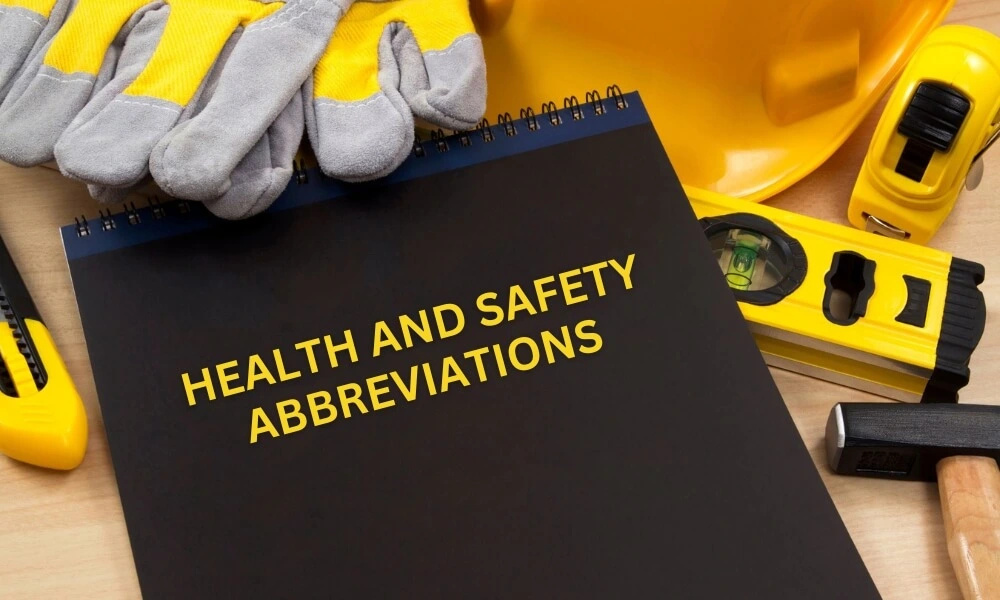Navigating the world of health and safety can often feel like deciphering a secret language. With many abbreviations being used daily, it can quickly become confusing for those new to the field or even for veterans who come across unfamiliar terms. We’ve compiled this comprehensive guide on health and safety abbreviations. Whether you’re a seasoned professional looking to brush up on your knowledge, or a newcomer seeking a firm grasp of essential terminology, this blog post is designed to clear up any confusion.
Read on to learn about the most frequently used abbreviations in health and safety, and arm yourself with the knowledge needed to communicate effectively in this vital sector. So, let’s dive into this linguistic sea and emerge with a clearer understanding of the language of health and safety.
Principal Abbreviations In Health and Safety
There are many abbreviations in health and safety, but the following are some of the most commonly used ones:
OSHA – Occupational Safety and Health Administration. This agency of the United States Department of Labor enforces safety regulations in the workplace.
ISO – International Organization for Standardization. This international organization sets standards for quality management and safety systems.
HACCP – Hazard Analysis and Critical Control Points. This system identifies, evaluates, and controls food safety hazards to prevent contamination.
EH&S – Environment, Health and Safety. This area of study focuses on protecting the environment and maintaining health and safety standards in the workplace.
MSDS: Material Safety Data Sheet. This document provided information about the potential hazards of a particular chemical or substance and recommended safety precautions to take when working with it.

PPE: Personal Protective Equipment. This includes items such as safety glasses, hard hats, respirators, and protective clothing that is used to protect the wearer from potential hazards in the workplace.
HVAC: Heating, Ventilation and Air Conditioning. This refers to systems that regulate temperature and air quality within a building.
HAZWOPER: Hazardous Waste Operations and Emergency Response. This is a federal program that establishes guidelines for the safe handling of hazardous materials, as well as emergency response procedures in the event of an incident.
AIHA: American Industrial Hygiene Association. This is an organization that sets standards and promotes education in the field of industrial hygiene.
COSHH: Control Of Substances Hazardous to Health. This UK-based safety regulation requires employers to take steps to protect workers from hazardous substances in the workplace.
LOTO: Lockout/Tagout. This is a procedure used to prevent accidental activation of machinery or equipment during maintenance or repair.
NFPA: National Fire Protection Association. This organisation sets standards for fire prevention and protection, as well as codes for the safe design and installation of electrical systems.
ACGIH: American Conference of Governmental Industrial Hygienists. This organisation sets guidelines for a safe, healthy work environment.
BA – Breathing apparatus. A type of personal protective equipment (PPE) that supplies air to a user, usually through an oxygen tank or canister.
ACL – Approved carriage list. This list of items approved for transport, such as hazardous and non-hazardous materials.
SDS – Safety data sheet. This is similar to an MSDS but provides information about the safe use, handling and storage of substances in a workplace.
ACM – Asbestos-containing material. Any material containing asbestos fibres, such as insulation or roofing, is used in construction.
ACOP – Approved Code of Practice. A document issued by the UK Health and Safety Executive (HSE) guides how to comply with a particular piece of health and safety legislation.
ALARP – As low as reasonably practicable. A risk management principle suggests certain risks should be reduced to the lowest level possible, even though they may not be technically feasible or economically viable.

ARCA – Asbestos Removal Contractors Association. This nonprofit organisation provides guidance, resources and training to asbestos removal contractors in the UK.
BSI – British Standards Institution. This UK-based organisation sets standards for products, services and processes in the United Kingdom.
CDM – Construction (Design and Management) Regulations. These are regulations in the UK that set out responsibilities for people involved in construction work.
dB(A) – Decibel (A-weighted) is a unit of measurement for sound intensity or loudness. It is used to assess the workplace noise level and ensure that it does not exceed legal limits.
DSE – Display screen equipment. This is equipment such as computers and other devices with screens, which employees use for their work.
DSEAR – Dangerous Substances and Explosive Atmospheres Regulations. This UK-based safety regulation sets requirements for controlling risks from dangerous substances and explosive atmospheres.
ELV – Exposure limit value. This measures the maximum exposure to a substance a worker can be exposed to without adverse health effects.
EPA – Environmental Protection Act 1990: This is a UK-based law that requires employers to take measures to reduce environmental pollution.
HAV – Hand-arm vibration. This is the vibration experienced in the hands and arms when using specific tools or machinery.
HGV – Heavy goods vehicle. This giant truck or lorry is used for transporting goods over long distances.
HSE – Health and Safety Executive. This is the UK government agency responsible for enforcing health and safety regulations in the workplace.
HSW – Act Health and Safety at Work etc. Act 1974. This UK law outlines the roles and responsibilities of employers, employees, and other parties to ensure workplace health and safety.
ILO – International Labour Office. This is a United Nations agency that promotes and ensures decent work conditions for workers around the world.
IOSH – Institution of Occupational Safety and Health. This non-profit organisation promotes health and safety in the workplace and sets standards for qualifications in this field.
LPG – Liquefied petroleum gas. This flammable gas consists of propanol, butane, and other hydrocarbons.
MEL – Maximum exposure limit. This is the highest level of exposure to a substance that is considered safe.
NEBOSH – National Examination Board in Occupational Safety and Health. This is a UK-based organization that awards qualifications in areas such as health and safety.
NVQ – National Vocational Qualification. This system of qualifications in the United Kingdom recognizes individuals who have achieved a certain level of knowledge, skills and competence in their chosen field.
OHSAS – Occupational Health and Safety Assessment Series. This is an international standard for occupational health and safety management systems.
OSH – Occupational Safety and Health. This field of study deals with the safety and health of workers in the workplace.

PUWER – The Provision and Use of Work Equipment Regulations. PUWER is a UK-based regulation that requires employers to take steps to ensure any equipment used in the workplace is safe for use.
RCD – Residual current device. This device is used to protect people and equipment from electrical shock in the event of an accidental short circuit.
RIDDOR – The Reporting of Injuries, Diseases and Dangerous Occurrences Regulations. This UK-based regulation requires employers to report certain workplace incidents, such as accidents and diseases.
RoSPA – Royal Society for the Prevention of Accidents. This UK-based organisation promotes safety at work, at home, and in public spaces.
RPE – Respiratory protective equipment. This type of personal protective equipment is used to protect the wearer from airborne contaminants.
WBV – Whole body vibration. This type of vibration can be caused by machinery or vehicles and can cause injuries to the body if not controlled.
WEL – Workplace exposure limit. This is the maximum amount of a particular hazardous substance an employer can allow workers to be exposed to in the workplace.
WHO – World Health Organization. This is an international agency that sets standards for public health and safety.
WRULD – Work-related upper limb disorder is an injury or condition caused by repeated and prolonged use of the arms, wrists, and hands in activities such as typing on a keyboard.
Knowing the standard abbreviations in health and safety is essential to communicating effectively in the field. By understanding these terms, you will be better equipped to take the necessary precautions and protect yourself from potential risks. Your knowledge of terminology can also help you to explain hazards more clearly and concisely to others. Ultimately, by familiarizing yourself with these abbreviations and their meanings, you will be more informed and prepared regarding health and safety in the workplace.

